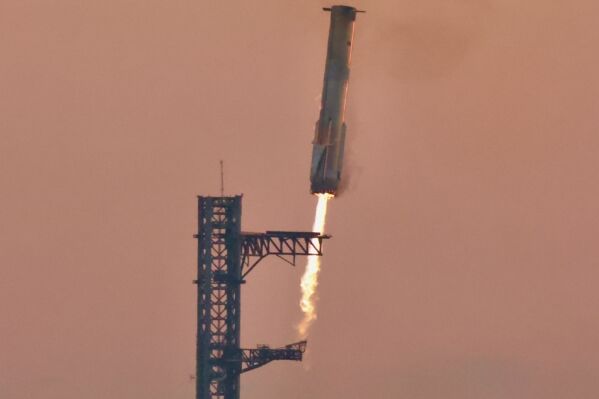SpaceX’s massive Starship rocket has the potential to transform the commercial space economy, ensuring America’s global leadership in the space race and sending humans to Mars for the first time. However, its first hurdle is to successfully reach orbit.
As the Starship test program accelerates, the company showcases the rocket’s increasingly powerful capabilities, making all of this more achievable. Yet, for many, the Starship is still seen as a vanity project of the world’s richest man. The following attempts to explain the origins of this rocket and its potential future direction.
The Starship stands at nearly 400 feet tall, making it the largest and most powerful rocket ever built. For comparison, the company’s Falcon 9 rocket is 229 feet tall, and the Saturn V rocket that sent Apollo missions to the moon was 363 feet tall.
The Starship also represents SpaceX’s raison d’être: as Musk puts it, to spread the “light of consciousness” throughout the solar system, starting from the Moon and Mars.
This rocket is composed of two parts: the Super Heavy booster and the second stage, also known as the Starship. During launch, the Super Heavy booster generates an astonishing 17 million pounds of thrust with its 33 Raptor engines. This is the power needed to send over 100-150 tons of cargo and personnel into low Earth orbit – equivalent to the Saturn V used for the moon landing, but more advanced in several aspects.
The biggest change is that the Starship is designed to be fully reusable, meaning both stages of the rocket will eventually return to the launch site, be quickly refurbished, and used for the next mission. This is a groundbreaking achievement in rocket history. While SpaceX pioneered booster reusability with the Falcon 9 rocket, its second stage remained in orbit and eventually burned up in Earth’s atmosphere.
Musk claims that this reusability, coupled with remarkable payload capacity, could reduce the launch costs for the Starship (for SpaceX) to $2-3 million per launch. Although precise cost details for each Falcon 9 launch are undisclosed due to SpaceX’s financial secrecy, their client price is $69.75 million.
Interstellar travel has been embedded in SpaceX’s DNA almost since its inception. Designing a heavy rocket capable of transporting tons of payload to low Earth orbit, the Moon, or even further planets has been a project with a two-decade history. Musk publicly discussed back in 2005 his plans to build a rocket with a payload capacity of up to 100 tons for low Earth orbit.
Previously known by several names such as the “BFR,” “BFS” (representing Big Falcon Rocket/Ship or Big F-ing Rocket/Ship), Mars Colonial Transporter, and Interplanetary Transport System, the rocket that is now called the Starship has had a long journey. In July 2019, a small-scale prototype rocket named “Starhopper” completed its first short-hop, and later, the first large demonstration rocket named SN15 successfully completed a high-altitude test flight in May 2021.
Of course, this journey has not been entirely smooth sailing: the company faced numerous prototype explosions along the way, with the first and second integrated flight tests in April and November 2023 both ending in mid-air explosions.
In recent years, the accelerated development of the Starship program is primarily attributed to two changes: the launch and operation of Starlink, SpaceX’s internet satellite constellation, providing crucial revenue for Starship development, and NASA’s $4 billion Human Landing System (HLS) award for developing a crewed Starship version to send humans to the Moon in support of the Artemis program. This leads to the next question.
The Starship is often viewed as a personal hobby project of a billionaire, but this is a profound misunderstanding of the purpose of the Starship or its potential role in the future space economy.
When the Starship enters commercial operations, almost all industry experts agree that it has the potential to fundamentally change the space economy. As mentioned, no other launch vehicle can be fully reusable, and those partially reusable vehicles cannot compare to the enormous size and power of the Starship rocket.
What does this mean? With the fundamental resolution of bulk cargo launch capacity, people can begin to imagine many incredible and unprecedented possibilities. However, it is essential that other related industries keep pace.
The Starship is not only crucial for the growth of the commercial space industry but also holds NASA’s hopes for the Artemis program. When NASA awarded the HLS contract to SpaceX in 2021 to deliver a crewed Starship capable of sending astronauts to the Moon, the award essentially transformed the Starship from one company’s ambition into a vital part of America’s continued dominance in space.
The sixth flight test is currently scheduled for November 18 or later. Here, we detail the main flight objectives of the test. The company will attempt to replicate past successful test flights, including capturing the Super Heavy booster with a giant “chopstick” arm extending from the launch tower and testing hardware and software upgrades.
According to Musk’s latest estimates, the Starship program is set to launch for Mars in 2026. Considering the orbital positions of the two planets around the Sun, this is the earliest opportunity for a mission to Mars. However, whether SpaceX can prepare the required rockets before such a long mission remains uncertain, mainly due to significant technological challenges that still need to be overcome, such as in-orbit refueling.
Indeed, to reach Mars, or even the Moon, the Starship will need to rely on Starship tankers orbiting in space for refueling. These tankers will replenish fuel before the main payload continues its journey. Multiple refueling processes will be required, with SpaceX planning to launch around 10 refueling tankers into orbit for the Artemis-3 mission.
In April, Musk told SpaceX employees that the Starship bound for Mars will not look exactly like what we see today. This interstellar Starship could reach a height of 500 feet and provide more space for astronauts and cargo.

